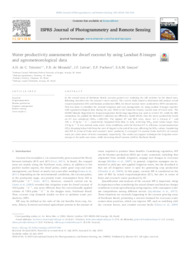Water productivity assessments for dwarf coconut by using Landsat 8 images and agrometeorological data.
Water productivity assessments for dwarf coconut by using Landsat 8 images and agrometeorological data.
Author(s): TEIXEIRA, A. H. de C.; MIRANDA, F. R. de; LEIVAS, J. F.; PACHECO, E. P.; GARCON, E. A. M.
Summary: In the coastal areas of Northeast Brazil, coconut growers are replacing the tall varieties by the dwarf ones, following incentives for the coconut?s water market. The current study aimed to determine and analyze actual evapotranspiration (ET) and biomass production (BIO), for dwarf coconut water productivity (WP) assessments. This was done to subsidize the rational irrigation and crop management, by using Landsat 8 images together with agrometeorological data during the year 2016 in the Camocim County, coastal zone of Ceará state. The SAFER (Simple Algorithm for Evapotranspiration Retrieving) algorithm was used to retrieve ET, while for BIO estimations we applied the Monteith?s radiation use efficiency model (RUE), then the water productivity based on ET was calculated (WPET=BIO/ET). The highest ET and BIO rates, above 4.0 ± 0.6mm d−1 and 140 ± 37 kg ha−1 d−1, respectively, happened from May to July, retrieving WPET pixel values larger than 3.5 kgm−3. It was noticed some water stress conditions, with the fraction ET to reference evapotranspiration (ET0) dropping below 0.60 from the start of August to the end of the year, affecting the WPET values. Considering also WP in terms of fruits and coconut?s water produced, it averaged 1.9 coconut fruits and 0.8 L of coconut water per cubic meter of water consumed, respectively. The results can support techniques for irrigation water storage at the palm root zones, while increasing dwarf coconut yield in Northeast Brazil.
Publication year: 2019
Types of publication: Journal article
Observation
Some of Embrapa's publications are published as ePub files. To read them, use or download one of the following free software options to your computer or mobile device. Android: Google Play Books; IOS: iBooks; Windows and Linux: Calibre.
Access other publications
Access the Agricultural Research Database (BDPA) to consult Embrapa's full library collection and records.
Visit Embrapa Bookstore to purchase books and other publications sold by Embrapa.

